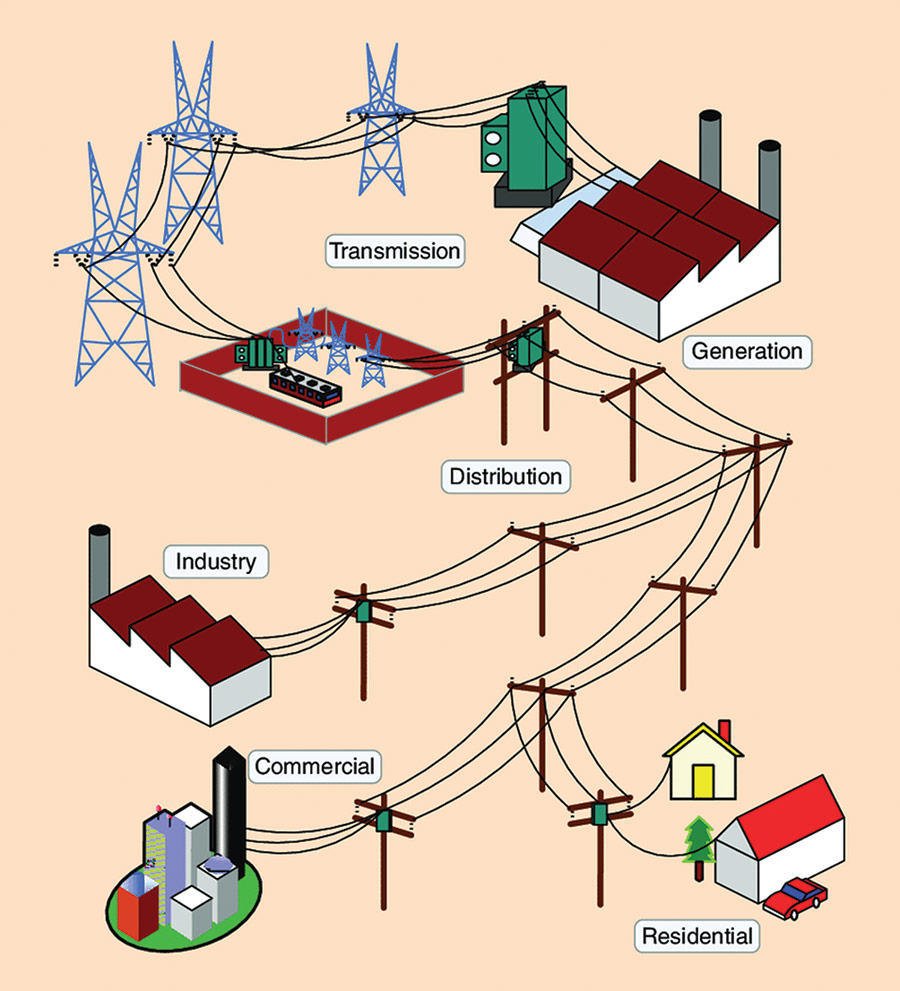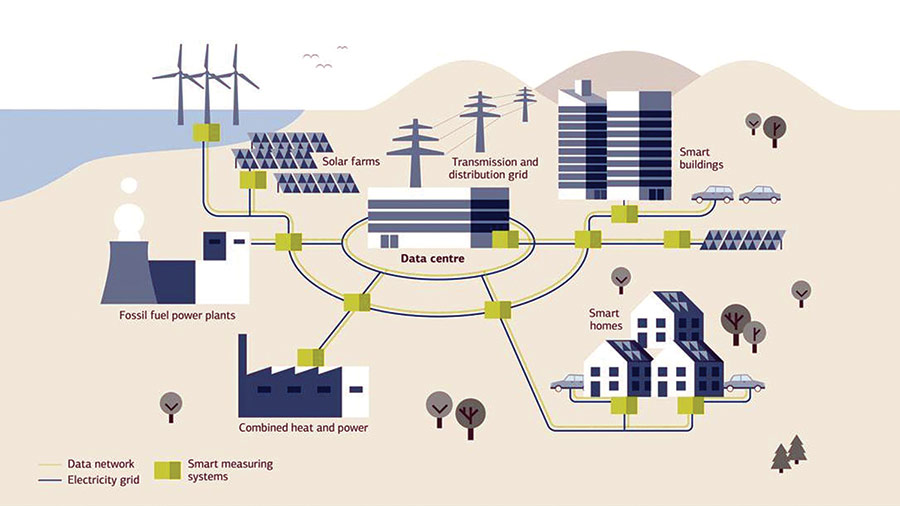By Kenneth Wacks December 15, 2021

Electricity generation is gradually shifting to the edge of the grid with local power generated from wind and solar at homes, buildings and community sites. © Ingo Bartussek
This article by Dr. Kenneth Wacks, the first in a nine-part series on energy management in homes and buildings, was originally published November 4, 2021 in the “CABA Journal” on the Continental Automated Buildings Association website (caba.org). Ken chairs the ISO/IEC committee developing international standards for energy management to promote world trade. These standards give users automated AI-based control over sources of power ranging from local solar, wind, and storage to transactive energy, microgrids, and public utilities. The objective is to ensure that the essential role of electricity continues, but from a diversity of sources that are more reliable, resilient to climate change, less polluting, and affordable.
Throughout most of the twentieth century, public policy and regulations encouraged utilities to expand the supply of electric power. Some regulators have encouraged this expansion by offering utility companies guaranteed returns on assets constructed such as generators and transmission lines. This contrasts with the usual method for judging business success by evaluating the return on funds invested. The expansion of utilities worldwide has been a major achievement. However, technology and environmental conditions are changing with profound effects on
the utility industry.
Electricity generation is gradually shifting to the edge of the grid with local power generated from wind and solar at homes, buildings and community sites. This is similar to the morphing of the central-office telephone-switching network to edge computing in our PCs, laptops, and smart phones for accessing Internet services such as VoIP,1 (voice over IP; telephone calls using the Internet), text, and email. These shifts are motivated by technology changes and public demands to ensure that the essential role of electricity continues, but from a diversity of sources that are more reliable, resilient to climate change, less polluting and affordable than depending on a single utility.
Standards are being developed to provide an orderly transition for these technical and societal changes. This is the first in a series of articles where I describe the emerging world standards to accommodate these changes by specifying energy management in homes and buildings. This article explains why these standards were written, what they cover and how they might affect consumer products.
International Standards for Energy Management
A series of international standards for energy management in homes and buildings is being issued by the leading world industrial standards bodies, ISO1 and IEC.2 These are part of a family of standards for interconnected consumer electronics (home automation) called the Home Electronic System (HES).
ISO and IEC formed a joint technical committee in 1987 to develop standards for information technology (IT). Some of the famous IT standards issued include Ethernet for local area network communications, JPEG for imaging, and MPEG for streaming movies. The IEC won an Emmy award this year from the National Academy of Television Arts & Sciences for the MPEG system providing “excellence in artistic, educational and technical achievements in television.” This is the fourth Emmy won by ISO and IEC for video coding systems (prior awards were bestowed in 2018, 2009 and 1996).
The HES family of home automation standards is developed by a committee of subject-matter experts appointed by the 46 member nations listed in the following table. The nations select which of the more than 1000 ISO and IEC technical committees to join.
I chair this committee,3 which has the following scope:
Standards for home and building electronic systems in residential and commercial environments to support interworking devices (IoT-related) and applications such as energy management, environmental control, lighting and security.
We have published about 55 standards and technical reports with another 17 proposed. About two dozen standards related to energy management are under development or have been issued since 2004.
The Evolution of our Electricity System
Public policy encouraging the expansion of electric power systems produced worldwide proliferation of electricity generation and power grids. It was not until the late 1980s that policymakers in some developed nations started to worry about whether the supply of electricity could increase to meet the anticipated demand primarily from industrial growth.
Some regulators mandated integrated resource planning, where utilities were ordered to consider both supply and demand when preparing budgets to justify tariffs. The utility industry responded by offering programs to manage customer demand for power called demand management.
The introduction of local power generation from wind and solar is adding impetus to demand management because the power generated by wind turbines and solar-voltaic cells can fluctuate quickly with changing weather and the availability of sunlight. Traditional demand management has been a centralized command-and-control system. Adoption varies widely by nation and by utility. Effective demand management is tailored to user wishes and equipment that is responsive to fluctuating supplies. User incentives for participation should be based on benefits and acceptable costs, not mandates and penalties.
ISO and IEC are addressing the need for user-centric energy management as options proliferate for local power generation from solar panels and wind turbines plus storage. The HES standards specify equipment in homes and buildings that enables consumers to manage their usage of electricity according to their activities requiring power for appliances, lights, electric vehicle charging, etc., and their budget.
Reliability and resiliency are important factors for maintaining essential services that depend on electricity. These standards allow users to draw power where available from local solar panels, wind turbines, energy storage, neighborhood microgrids, and public grids when needed. Since access to external services may be required to supplement local generation, the HES energy management standards for homes and buildings work with related HES gateway standards to link networks inside homes and buildings with external networks.
A Roadmap for Energy Management Standards
These articles presents a roadmap for energy management product developers to understand which HES standards are appropriate for various energy management devices and systems. These energy management standards are part of the HES family of standards, a cohesive set of standards for connected devices and systems in homes and buildings. These standards include communication protocols, device interfaces, network interfaces, applications (systems, components, and user interfaces) interoperability among applications and cybersecurity protection of user data, privacy and safety.
HES Mission
The Home Electronic System (HES) is a family of standards for the interconnection of electrical and electronic equipment and products for homes and buildings. The primary markets for HES standards are developers, manufacturers, and installers of these products and related services.
Typical HES equipment includes controllers, appliances, user interfaces and components such as sensors and actuators.4 These devices are interconnected via a local area network, often called a Home Area Network (HAN), using machine-to-machine communications. The term IoT (Internet of Things) is often applied to communications among HAN devices even if these devices do not use Internet protocols for communications.
The HES family comprises standards that enable home and building occupants:
- To live more comfortably in their homes;
- To be more protected and feel safe in their homes;
- To work productively in smart buildings; and
- To live and work more economically with minimal environmental impact by reducing energy consumption and/or producing and storing or selling excess energy.
HES standards facilitate consumer electronic products, communication networks and services to interoperate or to operate, where feasible, as a single coherent system. This system benefits all stakeholders including product developers, manufacturers, service providers, installers, utilities and consumers. HES consists of a network of networks that enables interoperation among consumer products, sensors, control devices and user interfaces in homes and buildings with the potential for access to external services.
HES Relationship to Smart Grids
The term “smart grid” was introduced early in the 21st century to mean a modernization of the traditional electric power system, shown in Figure 1. Much of the grid installed in the 20th century operates “open loop” without many remote sensors to monitor operations. For example, many utilities still depend on customers to report power outages because these utilities do not have field equipment installed to detect a fault that affects one or a few customers. The initial “smart grid” overlaid the existing grid with a communications network and sensors so a server could monitor the grid. Later “smart” concepts extended “smart grids” to include the gateway and premises-based solar power and wind generation, as shown in Figure 2.

Figure 1: Traditional electric grid. © ResearchGate/Xinghuo Yu

Figure 2: Smart Grids. © Kfw.de https://bit.ly/3pck4AT
Applications of HES Standards
Products and services based on HES standards support applications such as entertainment, lighting, comfort control, life safety, health and energy management. Energy management has become important with the evolution of smart grid programs for electricity. Energy efficiency, reliability, resiliency and reduction of greenhouse gases are topics of global interest addressed by HES standards. HES standards support energy management for appliances and electric-vehicle (EV) chargers within homes and buildings.
HES energy management standards depend on networks within homes and buildings. The ISO/IEC 10192 series of HES standards specify communication interfaces between devices and networks in homes and buildings using HES communication protocols specified in the ISO/IEC 14543 series of HES architecture standards.
The HES Gateway
Among the applications included within the HES family of standards are energy management and the interaction between energy sources (electricity, gas, water and heat) and systems in homes and buildings. These standards enable the interfacing of enhanced energy grids (sometimes called “smart grids”) and devices connected to networks in homes and buildings. As noted, connections to the outside world are provided by a gateway. The HES family includes HES Gateway standards specified in the ISO/IEC 15045 series. The HES Gateway provides not only communications, but also offers cybersecurity protection for consumer data, privacy and safety.
This series of CABA Journal articles includes an overview of the HES standards for energy management and related services enabled by the HES Gateway. The home and building automation industries exist in a competitive environment of premises-based communication networks, most of which are incompatible with each other. The HES Gateway provides a traditional communications interconnection between a home network and a public network plus additional services:
- Interoperability among applications installed on many of the diverse home and building networks used for wired and wireless communications;
- Cybersecurity protection for user data, privacy, and safety; and
- A hosting platform for applications.
Accessing and Developing HES Standards
Abstracts for all published ISO/IEC standards are accessible at https://iso.org by entering the standard number in the search field. Specification documents for published standards are available worldwide at ISO and IEC, and in North America at the American National Standards Institute (ANSI) and Standards Council of Canada (SCC):
- ISO: https://www.iso.org/store.html
- IEC: https://webstore.iec.ch
- ANSI: https://webstore.ansi.org
- SCC: https://www.scc.ca
Standards are developed and approved by representatives from the member nations of ISO and IEC. Each standard is rigorously reviewed and must be approved in multiple ballots by a super-majority of voting nations:
- At least two-thirds YES among the voting nations;
- Less than one-quarter NO among the voting nations; and
- At least five countries must name a subject-matter expert to participate in the development of the standard.
Experts wishing to join a standards committee should contact their national body. Here are the administrators for North America:
- Canada: Please submit an application to https://bit.ly/3nlwC9b
- USA: Please join the US Technical Advisory Group (TAG) for ISO/IEC
JTC 1/SC 25/WG 1 by contacting:
Ms. Florence Otieno, Director, International Standards Programs
fotieno@tiaonline.org
(703) 907-7556
The HES Energy Management Roadmap
I am planning additional articles about the HES energy management roadmap on the following topics:
- The evolution of energy management from utility-centric to user-centric;
- The Energy Management Agent (EMA) for automated user-centric energy management;
- Adapting to users with multiple EMAs in an apartment complex;
- The EMA for Transactive Energy;
- Measuring and allocating power with the EMA;
- Device and user interfaces for effective energy management;
- Appliance design for responsive energy management;
- Applications of Artificial Intelligence (AI) to the EMA;
- The HES Gateway as the sentry and service platform for homes or buildings;
- Providing interoperability between incompatible home systems using the HES Gateway;
- Cybersecurity protection for user data, privacy, and safety offered by the HES Gateway;
- HES Gateway services providing an application platform as a home hub; and
- Market opportunities for incorporating energy management into consumer electronics.
About the Author
Dr. Kenneth Wacks has been a pioneer in establishing the home systems industry. He delivers clear and practical advice to manufacturers and utilities worldwide on business opportunities, network alternatives, and product developments in IoT and AI for home and building systems. He was appointed to the United States Department of Energy GridWise® Architecture Council to guide the electric industry toward smart grids. Ken can be reached at (781) 662-6211; kenn@alum.mit.edu; www.kenwacks.com
Sources
1 ISO is the International Organization for Standardization, founded in 1947, www.iso.org.
2 IEC is the International Electrotechnical Commission, founded in 1906, www.iec.ch. Both ISO and IEC are headquartered in Geneva, Switzerland.
3 The Home Electronic System (HES) is the name of the international standards committee officially designated as ISO/IEC JTC 1/SC 25/WG 1:
JTC 1 = Joint Technical Committee 1, entitled Information Technology
SC 25 = Subcommittee 25, entitled Interconnection of Information Technology Equipment
WG 1 = Working Group 1, entitled Home Electronic System.
4 Sensors measure physical parameters such as temperature. Actuators cause a physical device to change state, such as turning a motor on or off.




